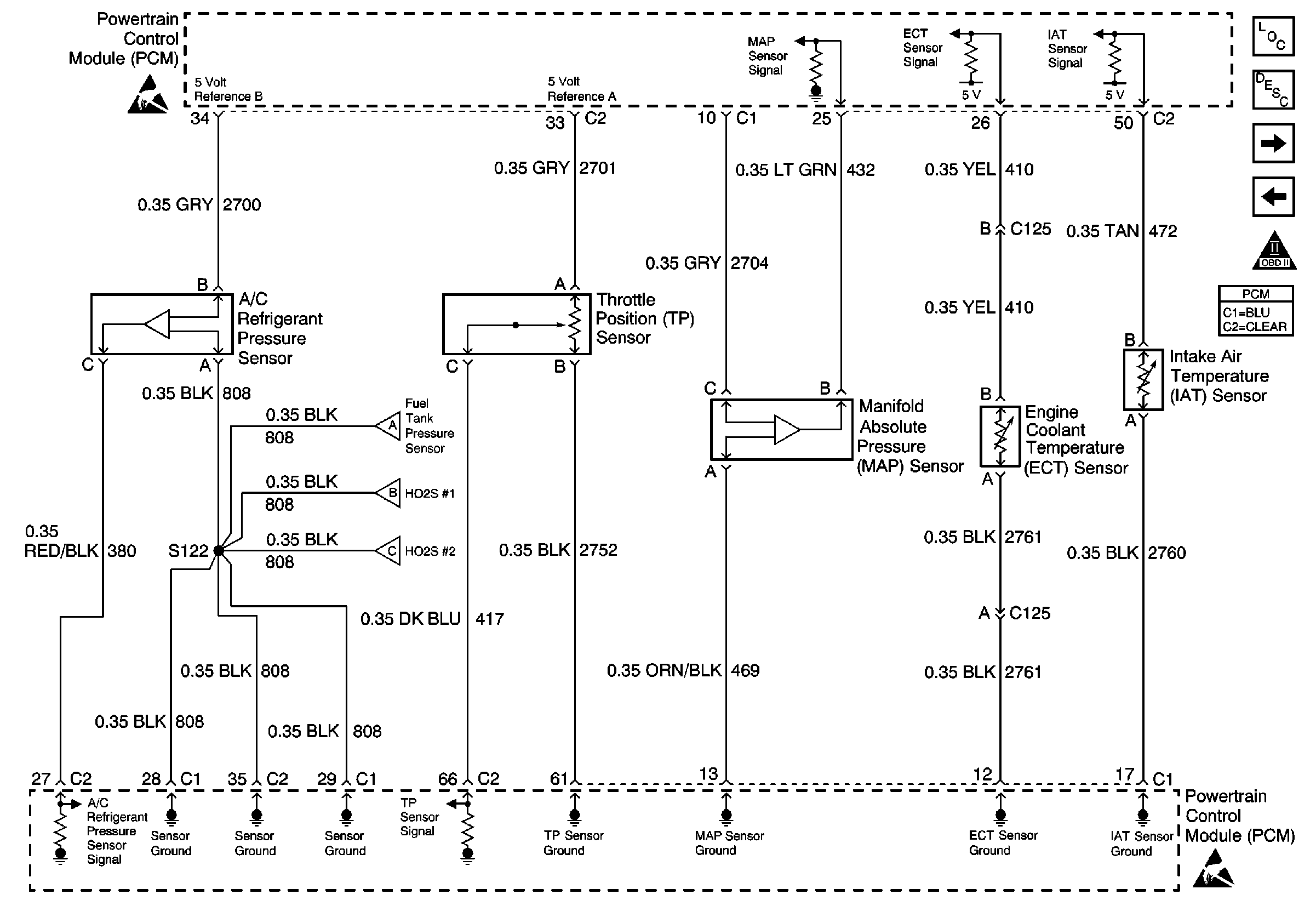Refer to Engine Controls Schematics
A/C Pressure Switch, TPS, MAP, ECT and IAT

.
Circuit Description
The engine coolant temperature (ECT) sensor contains a semiconductor--a device that changes resistance based on temperature. The ECT sensor has a signal circuit and a ground circuit. The PCM applies voltage of about 5.0 volts to the sensor on the signal circuit. The powertrain control module (PCM) monitors any voltage changes caused by changes in the resistance of the sensor, and uses this information to determine the engine coolant temperature.
When the engine coolant is cold, the sensor resistance is high, and the PCM signal voltage is only pulled down a slightly through the sensor to ground. The PCM, therefore, senses a high signal voltage or a low coolant temperature. When the engine coolant is warm, the sensor resistance is low, and the signal voltage is pulled down a greater amount. This causes the PCM to sense a low signal voltage or a high temperature.
Conditions for Running the DTC
The engine running time is longer than 3 seconds
Conditions for Setting the DTC
| • | The ECT sensor signal indicates an engine coolant temperature of less than -13°C (+9°F). |
| • | The above condition is present for at least 10 seconds. |
Action Taken When the DTC Sets
| • | The PCM illuminates the malfunction indicator lamp (MIL) on the second consecutive ignition cycle that the diagnostic runs and fails. |
| • | The PCM records the operating conditions at the time the diagnostic fails. The first time the diagnostic fails, the PCM stores this information in the Failure Records. If the diagnostic reports a failure on the second consecutive ignition cycle, the PCM records the operating conditions at the time of the failure. The PCM writes the conditions to the Freeze Frame and updates the Failure Records. |
Conditions for Clearing the MIL/DTC
| • | The PCM turns the MIL OFF after 3 consecutive drive trips during which the diagnostic runs and passes. |
| • | A last test failed, or the current DTC, clears when the diagnostic runs and passes. |
| • | A History DTC clears after 40 consecutive warm-up cycles, if no other emission related diagnostic failures are reported. |
| • | Use a scan tool in order to clear the MIL diagnostic trouble code. |
| • | Interrupting the PCM battery voltage may or may not clear DTCs. This practice is not recommended. Refer to Powertrain Control Module Description , Clearing Diagnostic Trouble Codes. |
Diagnostic Aids
Check for a skewed or incorrectly calibrated ECT sensor. Refer to the Temperature Versus Resistance table.
If DTC P0118 cannot be duplicated, the information included in the Fail Records data can be useful in determining vehicle mileage since the DTC was last set.
If the problem is intermittent, refer to Intermittent Conditions .
Test Description
Numbers below refer to the step numbers on the diagnostic table:
-
Verifies that the malfunction is present.
-
If DTC P0118 can be repeated only by duplicating the Failure Records conditions, refer to the Temperature vs Resistance table.
-
This vehicle is equipped with a PCM which utilizes an electrically erasable programmable read only memory (EEPROM). When the PCM is replaced, the new PCM must be programmed.
Step | Action | Value(s) | Yes | No |
|---|---|---|---|---|
1 | Did you perform the Powertrain On-Board Diagnostic (OBD) System Check? | -- | ||
Observe the ECT displayed on the scan tool. Is the ECT less than the specified value? | -31°C (-24°F) | |||
Does the scan tool indicate DTC P0118 failed? | -- | Go to Diagnostic Aids. | ||
4 |
Is the ECT more than the specified value? | 130°C (266°F) | ||
5 |
Was a problem found and corrected? | -- | ||
6 |
Is the ECT more than the specified value? | 130°C (266°F) | ||
7 |
Was a problem found and corrected? | -- | ||
8 |
Was a problem found and corrected? | -- | ||
9 |
Was a problem found and corrected? | -- | ||
10 |
Was a problem found and corrected? | -- | ||
11 | Replace the ECT sensor. Refer to Engine Coolant Temperature Sensor Replacement . Is the action complete? | -- | -- | |
|
Important: The replacement PCM must be programmed. Replace the PCM. Refer to Powertrain Control Module Replacement/Programming . Is the action complete? | -- | -- | ||
13 |
Does the scan tool indicate that this test ran and passed? | -- | ||
14 | Review the Captured Info using the scan tool. Are there any DTCs that have not been diagnosed? | -- | Go to the applicable DTC table | System OK |
